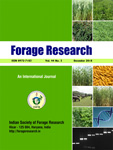MANISH V BORATKAR*, HASANALI NADAF, ANIL REDDY AND PRABHAKAR BABU GUNTURU
Foragen Seeds Private Limited, Hyderabad-500034 (Telangana), India
*(e-mail: mb.cotbreeder@gmail.com)
(Received: 03 June 2025; Accepted: 28 June 2025)
SUMMARY
Principal component and hierarchical cluster analyses were carried out with six quantitative characters of hundred and ninety four brown midrib sorghum advanced breeding lines. Principal factor analysis identified three principal components which explained about 62.5 % variability. PC 1 explained maximum variability of 24.7% of total variation for morphological characters and PC 2 loaded with 20.2% of total phenotypic variability and PC 3 had contributed 17.5 % of the total variation. PCA revealed that Days to 50% flowering, Plant height (cm), Internode length (cm) and Green fodder yield (t/ha) depending upon their loading variables on a common principal axis. Brown midrib Sorghum advanced breeding lines viz., FBMRS-24, FBMRS-31, FBMRS-42, FBMRS-43, FBMRS- 87, FBMRS-88 and FBMRS-167 were identified as superior lines based on principal component analysis. Hierarchical cluster analysis emphasized on 194 BMR sorghum advanced lines and grouped into twenty clusters. Cluster number 1 had only two lines and both were to be superior for highest green fodder yield and highest brix percentage. Both PCA and clustering registered same level of variability between breeding lines. Hence these superior brown midrib advanced breeding lines may further be utilized in breeding programmes for developing BMR sorghum varieties with high yield and for developing high yielding BMR hybrids.
Key words: Brown midrib, sorghum, green fodder yield and brix percentage

